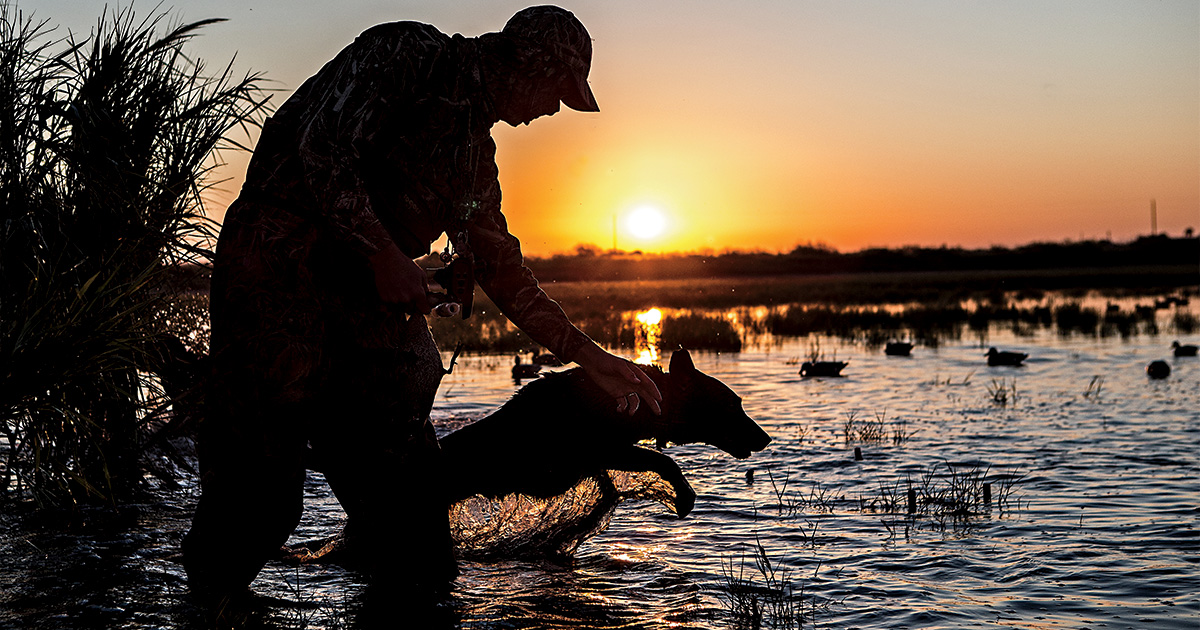Cupped Wings: Lost
The ducks deserve our best efforts to reduce crippling losses
The ducks deserve our best efforts to reduce crippling losses

Hunting with a well-trained retriever will help ensure that downed birds are recovered.
We looked for that duck for a long time. We sent the dog first, but he came back empty. We’d marked the spot where the bird fell, then walked a straight line from the blind to where it had disappeared in the cattails. We walked in expanding concentric circles. We looked in a grid pattern. Nothing. After 20 minutes, we were just wandering aimlessly, kicking at brush piles, hoping to stumble onto the crippled bird.
The mallard had gone down hard. I didn’t think it had much life left, but somehow it had enough gas in the tank to burrow so deeply into the cattails that it couldn’t be seen, or it had pushed its way free of the brush and kept going. The details didn’t matter. For whatever reason, I had lost the bird, and losing a bird leaves a gnawing in my gut. It’s an unavoidable aspect of waterfowling, but I’ve never gotten comfortable with the reality of lost game. To be honest, I hope I never do.
I’ve wrestled with the issue of crippled birds for a long time. On the one hand, I have no moral qualms with the fact that we knock down birds we never collect. This is part of the compact between predator and prey. Sometimes the rabbit slips from the bobcat’s claws. But occasionally there’s a duck that gets away that strikes a different chord.
The last duck I shot this past season was a stunning, gorgeous greenhead that came in at mid-morning. It was lit up with sunlight, straight overhead, and I swear I could see a glint in its eye. My shot broke a wing, and the bird tried to stay aloft, head up and alert, the single wing pumping furiously. Then it went down behind a levee, on the far side of a channel. After 45 minutes of trying to find that bird, I had nothing to show for it. It was a tough way to end the season. That left a gnawing in my gut that stuck around for a while.
It’s all a part of the moral calculus I work out as I honestly think about what I’m doing. A growing part of that calculus has been a proactive effort to do everything I can to cut my crippling rate. I shoot higher quality shells, and I match the load to the hunting situation. In the hopes of getting birds to finish just a few yards closer, I’ve reconsidered how to deal with camouflage. And I’ve become a more conservative shooter, although my hunting pals will tell you that’s nothing new.
It’s easy to say, Oh, it’s just a duck. And, let’s be honest, some folks think that way. On the other hand, there is this: It is a duck. It is a wild animal that could have thousands of miles on its odometer. It survived a perilous youth and possibly drought and who knows how many close calls with hawks and foxes. It’s a little piece of wetlands and waterfowl conservation come to life, and it deserves better than a why-not, maybe-I’ll-get-lucky, sling-some-steel shooting attempt from a distance that I know pushes the envelope. At least for me.
Perhaps I’m being overly sensitive. It’s the end of the season, and we’re all a little sleep-deprived and punchy. But it’s also a good time for reflection and analysis. So here’s one more memory. One I feel good about. This took place this season, hunting Puget Sound. We’d had a great shoot on green-winged teal and had taken a few pintails when a lone mallard drake winged over my side of the set. It was a bit of a poke, but totally doable. I raised the gun and tracked the bird overhead, but I never pulled the trigger.
“Why didn’t you shoot?” my buddy asked. I didn’t know what to tell him. There was something about the angle, something about the timing. I couldn’t say. Something inside told me not to shoot, not this time. So, I lowered the gun and shrugged. I’ve reconciled myself to not always having the answer. And not always needing it.